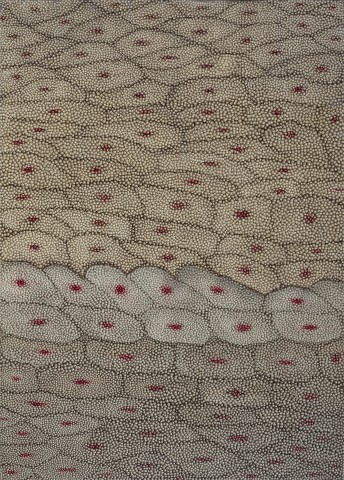MOLECULAR BASIS, 1998
ROSS BLECKNER
oil on canvas
213.0 x 152.0 cm
signed, dated and inscribed with title verso: Ross Bleckner / Ross Bleckner / 1998 / Molecular / Basis
Baldwin Gallery, Aspen, USA (label attached verso)
Private collection, Sydney, acquired from the above in January 1999
Ross Bleckner: New Paintings, Baldwin Gallery, Aspen, USA, December 1998 – January 1999
ROSS BLECKNER Paintings 1996 – 1999, Martin Browne Fine Art, Sydney, 3 – 29 November 1999, cat. 4 (illus. in exhibition catalogue); then Gallery Gabrielle Pizzi, Melbourne, 6 – 24 December 1999
ROSS BLECKNER Paintings 1996 – 1999, Martin Browne Fine Art, Sydney, 1999, pp. 10, 11 (illus.), 35
Presenting an intricate expanse of abutting cells, each composed of countless identical spherical particles, Molecular Basis, 1998 is a hypnotic investigation into the inherent vulnerabilities in the underlying architecture of human life. Replicating in a luminous grey palette a pellicle of human tissue from a pathology slide and enlarging its microscopic code to a vast painterly format, Ross Bleckner mirrors the contemporary scientific developments which have shed light on invisible threats.
American painter Ross Bleckner first came into prominence in the 1980s, steadfastly creating diaphanous and technically refined tableaux in oils, flying in the face of dissenters who decried the ‘death of painting’ – viewing it as an obsolete practice being superseded by the advent of conceptual and post-modern art. In New York, Bleckner’s immediate community was heavily impacted by the AIDS epidemic, a cataclysmic event that has informed his artistic and activist practices ever since. The artist later reflected: ‘I think the awareness of AIDS – first a slow, creeping awareness, then that very explosive, devastating awareness politicised me a lot – like many gay men... it forced me to play my hand more directly... I wanted whatever had been more latent in my work to be more explicit.’1 An acute understanding of bodily vulnerability and mortality hence has underpinned Bleckner’s paintings, op-art abstractions and Rococo dreamscape interiors alike, infusing their formal decorative appearance with an elegiac quality. Although these decorative patterned surfaces are ‘concerned with the same classic complex of themes: questions of the beginning and the end, life and death, light and darkness, and bound up with them the desire for order and a yearning for beauty’, they remain fundamentally realist paintings describing a clear landscape of cellular structures as viewed through an electron microscope.2
Molecular Basis was painted at the height of Bleckner’s ‘Cell painting’ period, evoking the tenuous links of life clearly and profoundly. While Molecular Basis’ lattice-like surface echoes Yayoi Kusama’s iconic infinity nets and Terry Winters’ biomorphic gestural abstraction, Bleckner’s network of stylised clusters of cells is scientifically and physically distanced from individual human experience. Instead of retaining painterly brushstrokes, Bleckner’s paint begins as a random distribution of nuclei and all traces of human agency are slickly airbrushed away, leaving a translucent and uniformly matte surface. The idiosyncrasies of Bleckner’s new technique were detailed in a review of his two 1999 solo exhibitions in the periodical Art in America: ‘To create the look of multitudes of three-dimensional ‘cells’, he places the canvas on the floor and sprinkles it with dots of oil pigment. While still wet, each dot is blasted with a powerful, finely focused airbrush, which smooths out the paint into a more-or-less round spot with dark edges and a lighter-hued, translucent centre; sometimes bare canvas is revealed, at other times a coloured ground.’3
Bleckner’s work was first shown in Australia during the 1988 Biennale of Sydney, appearing again in the nineties at the National Gallery of Australia’s exhibition on artworks responding to the AIDS crisis: ‘Don’t Leave Me This Way’. Molecular Basis was purchased in the United States and later included in Bleckner’s first solo exhibition in Australia, presented by Martin Browne and Gabrielle Pizzi.
1. Interview with Dan Cameron, Art Forum, New York, March 2003, vol. 41, no. 7, see https://www.artforum.com/columns/ross-bleckner-165808/ (accessed 29 May 2024)
2. Fischer, P., ‘Ross Bleckner’, In The Power of Painting, Alesco AG, Zurich, 2000, p. 121
3. Ebony, D., ‘Ross Bleckner at Mary Boone and Lehmann Maupin’, Art in America, April 1999, p. 139
LUCIE REEVES-SMITH

